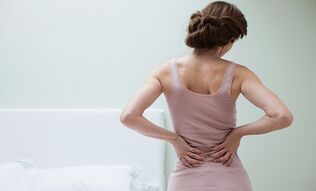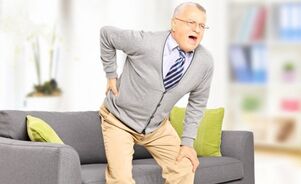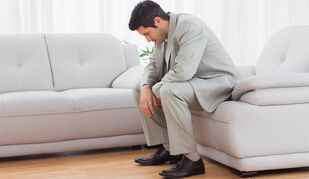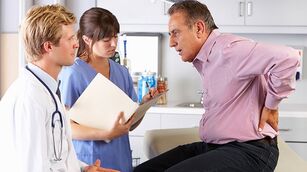
The most common cause of back pain is the development of a disease of the musculoskeletal system such as osteochondrosis. If previously this pathology was found mainly in older people and less often in middle age, now osteochondrosis has become much younger, it is often diagnosed in people aged 20-30 years.
According to medical statistics, most of the time the disease affects the lumbar and lumbosacral spine.
Characteristics of the disease
Osteochondrosis is a pathology of the musculoskeletal system that affects its most important component - the spine. It arises due to the fact that the dystrophic changes in the intervertebral discs begin to develop.
The disease does not only affect the tissue of the intervertebral discs, negative changes begin to occur in the surrounding tissues, affecting the ligaments and muscles.
The reason for the prevalence of the lumbar form of osteochondrosis is that this specific part of the spine is subject to the greatest physical stress.
With this disease, characteristic changes occur in the nucleus pulposus, which is part of the intervertebral disc. This disc performs amortization functions.
If the water exchange in the intervertebral discs is disturbed, they will become thinner and their fragility will increase.
People in older age groups are more susceptible to the pathological process, as the metabolic processes in the tissues of the intervertebral discs begin to deteriorate when they reach a certain age.
Under the influence of negative changes, the limits of the nucleus pulposus gradually expand, it tends to enter the intervertebral space. This usually ends with the displacement of the nucleus to the spinal canal, as a result of which it is compressed and pinched by nerve fibers and blood vessels.
Compressed nerves are the cause of pain in osteochondrosis. There may also be a deterioration in the functioning of Organs internal organs.
As the pathology progresses, the pressure force on the vertebrae increases. The body seeks to compensate for the defect and the growth of bone tissue in the spine is significantly accelerated. As a result, pathological growths - osteophytes - form in the vertebrae. Ultimately, this further disrupts the functionality of the affected column.
In advanced forms of osteochondrosis, the patient may experience paralysis of the lower limbs. Due to late access to medical care, a person may be disabled.
Causes of osteochondrosis of the lumbar spine and lumbosacral
Osteochondrosis of the lumbar spine and lumbosacral develops due to inadequate load distribution in the spine. If this is combined with other negative factors, the progression of osteochondrosis is accelerated and can take on more serious forms.

The disease can be caused by:
- regular heavy physical work, lifting heavy objects (people in certain professions, as well as athletes involved in weight lifting, are at risk);
- insufficient physical activity, which negatively affects the condition of the muscles and leads to a deterioration of blood circulation, metabolic processes and a decrease in the amount of nutrients entering the tissues;
- the patient is overweight, which leads to the fact that the spine is constantly exposed to great stress;
- problems with posture and inadequate gait;
- the presence of congenital deformities or other defects in the spine or the entire skeleton;
- flat feet can also cause the development of osteochondrosis, since in patients with foot deformity, their arch cannot fully absorb the load during movement, which leads to increased loads on the intervertebral discs;
- traumatic injury to the spine;
- genetically determined diseases of bone tissue formation;
- age-related changes;
- infections that affect bone tissue (tuberculosis, osteomyelitis);
- inflammatory processes that affect bones and joints (including rheumatoid arthritis, ankylosing spondylitis);
- deficiency of vitamins and minerals;
- exposure to harmful and toxic substances.
The most common cause of pathology is heavy spinal loads in patients with inadequate posture.
Symptoms of the disease
The manifestation and severity of osteochondrosis symptoms depend on the stage of the disease.

There are 4 stages of the disease:
- The first stage is characterized by the appearance of pain in the lower back (lumbago), spasms of the surrounding muscle tissues and swelling in the affected area. During this period, an alteration and displacement of the pulpal nucleus of the intervertebral discs begins, which causes irritation in the nerve endings.
- In the second stage, the process of destroying the fibrous rings of the intervertebral discs begins. The vertebrae become unstable, their mobility increases, which results in constant tension in the surrounding muscles. Pain is seen along the sciatic nerve. At this stage of the disease, disruptions in the functioning of internal organs can sometimes occur.
- During the third stage, the rupture of the fibrous rings and the release of the pulpous nucleus is observed. As a result, herniated discs are formed. All of this contributes to a greater deformation of the spine (the development of scoliosis, kyphosis or lordosis can be observed). Acute pains become permanent, this is due to the root syndrome, in which the nerve roots are compressed by fragments that have fallen from the fibrous rings.
- The fourth stage is characterized by severe spinal deformities, pathological growths appear in the vertebrae. There may be significant pain relief, but that does not mean an improvement in the patient's condition. On the contrary, a person's movements are severely limited. Typically, patients with stage 4 osteochondrosis require a disability record.
One of the main symptoms of the disease is pain in the lower back, which can also spread to the coccyx and lower extremities. It is divided into 3 types:
- Lumbago- acute pain attacks that start when making sudden movements or lifting heavy objects.
- Lumbodynia- severe and regular pain associated with damage to the intervertebral cartilage and muscle fibers.
- Lumboishalgia- characterized by a sensation of pain, a feeling of cold or heat in the lower back, as well as in the legs.

A person's psychological state can also cause pain.
In addition to pain, osteochondrosis is characterized by:
- feeling of weakness in the lower half of the body and legs;
- deterioration of tendon reflexes in the lower extremities;
- tingling, which can be felt from the lower back to the feet;
- curvature of the spine;
- with lumbosacral osteochondrosis, there is often a malfunction of Organs pelvic organs (urinary disorder, fecal incontinence, erectile dysfunction);
- skin problems (dryness, flaking, bluish tint) and changes in sweating can also occur on the lower back and buttocks.
If you find the symptoms listed, you should see a doctor as soon as possible to start treatment immediately and avoid serious consequences.
Treatment of lumbar and lumbosacral osteochondrosis
Doctor
A patient diagnosed with osteochondrosis can receive the following types of therapy (including several at once):
- drug treatment;
- physiotherapy procedures;
- medical massage and manual therapy;
- performing a surgical operation.

Let's take a closer look at each of these methods.
Medicines are prescribed to relieve pain, fight inflammation and improve the regeneration of diseased tissues. The patient can be assigned:
- pain relievers (help to relieve pain);
- muscle relaxants (used to relax muscle fibers and relieve spasms);
- chondroprotectors (promote the regeneration of cartilage and bone tissue and protect them from negative influences);
- anti-inflammatories;
- in case of edema, diuretics (diuretics) are prescribed;
- medicines to improve blood circulation;
- vitamin and mineral complexes.
In common forms of osteochondrosis, when conventional pain relievers are ineffective, blocks can be prescribed. The specific medications to be used, as well as the treatment schedule and duration, are determined by the doctor, taking into account the stage of the disease and the severity of the symptoms.
It is advisable to prescribe physical therapy along with medications to increase the effectiveness of the treatment. In osteochondrosis, the following procedures are indicated:
- laser therapy;
- magnetic resonance therapy; phonophoresis
- ;
- shockwave therapy.

These treatments help to relieve pain, reduce inflammation and help repair damaged tissue. The use of a laser beam is very effective, which allows a stable remission.
When prescribing phonophoresis, additional topical medications are used (this method allows the medication to penetrate deeply under the skin, directly into the lesion). To maximize tissue enrichment with oxygen, the doctor may also prescribe ozone therapy.
It must be kept in mind that physical therapy is contraindicated in certain pathologies. It should not be prescribed to patients with oncological diseases, thyrotoxicosis, diabetes, tuberculosis, infectious diseases.
Massage and manual therapy can be prescribed simultaneously with medications and physiotherapy procedures, which enhances the therapeutic effect.
These methods affect the conduction of nerve impulses and help to normalize muscle tone.
Surgical intervention is indicated only in the most advanced stages of the disease, when other treatment methods are useless. Surgery is necessary if:
- the patient suffers from severe pain that cannot be controlled by medication;
- herniated disc;
- the patient is diagnosed with spinal cord compression (this leads to decreased sensitivity and motor functions - from a feeling of weakness to paralysis);
- the development of horse tail syndrome is observed.
Nowadays, modern high-tech and low-trauma operations are being performed more and more frequently, allowing to significantly reduce the rehabilitation period. In the absence of complications, the patient will be able to move normally a few months after surgery.
Folk remedies
Traditional medicine treatments help to relieve pain, reduce inflammation and improve mobility. Here are several ways to treat osteochondrosis with folk remedies.
- You need to take the raw potatoes, grate and mix with natural honey. The resulting mixture should be placed on the back and protected with a dressing for at least 2 hours. Applying hot boiled potatoes to the affected area also helps.
- Grate the garlic and mix in equal parts with the ginger. Then add a little olive oil. The resulting medication should be applied to the back at night to improve blood circulation and reduce muscle tension.
- Mix a spoonful of menthol oil with a spoonful of fir oil. The mixture should be rubbed on the back.
- Take the chopped pine or fir needles in the amount of ½ tablespoon per 200 ml (1 cup) of boiling water and boil for 30 minutes. Drink ½ cup 2 times a day.
- Mix a tablespoon of lingonberries and mint herbs, boil with boiling water (1 cup), let it ferment and strain. Drink the broth gradually throughout the day.
It is important to understand that treatment with folk remedies cannot replace a visit to the doctor. Popular methods temporarily relieve symptoms, but do not completely eliminate the disease.
In addition, they may not be suitable for all patients, so it is highly recommended to consult a specialist before using them.
Physiotherapy exercises
Physiotherapy aims to strengthen the muscles of the lower back, buttocks and thighs, which helps to relieve pain, reduce the degree of pinching of nerves and blood vessels and restore flexibility.
In order for the exercises to be as effective as possible and do no harm, certain guidelines must be followed:

- The exercises should be performed with clothes of natural fabric that do not restrict movements;
- the lower back during physical education should not be hypothermic;
- if you need to lie down to perform the exercise, it is best to place a round roll under your leg;
- you should not start exercising until an hour after eating;
- to obtain a sustainable positive effect, it is necessary to practice physical therapy exercises regularly;
- exercises should be performed in a smooth, slow manner, focusing on muscle work;
- you need to monitor your breathing, it must be even and deep;
- It is useful to keep a diary that includes changes since the day you started doing the exercises.
The exercises to be performed depend on the severity of the symptoms of osteochondrosis.
In acute lumbar osteochondrosis, the spine must not be overloaded, one must adhere to absolute rest (preferably on an orthopedic mattress) and do physical education lying on his back, repeating each movement 8 to 10 times. Here are some suggestions:
- Lying on your back, place a roll under your shins and bend your knees. The patient must bend his arms in fist and unfold, and he must also bend his legs at the ankle. These movements are done alternately with each arm and leg.
- You need to alternately bend and unfold your legs, moving only your knees. At the same time, the back must not move.
- Rotate each foot in turn.
- Extend your arms and legs, then start flexing and extending the elbows of both arms at the same time. During flexion, you need to inhale and, during extension, exhale. Keep your palms up.
Recommended exercises for subacute lumbar osteochondrosis:
- With your knees bent in a supine position, rest your feet on the mattress. As you inhale, gently lift the sacrum, while the lower part of the thoracic spine should rest on the mattress. After 1-2 seconds, gently lower the lower half of your back.
- Lying on a mattress, while inhaling, you need to lift your head and contract your abdominal muscles. When exhaling, return to the starting position.
- In the supine position, pull the heel up to the buttocks in a sliding motion, without lifting it from the mattress. After a few seconds, stretch your leg. The movements must be repeated for each leg separately and for both legs at the same time.
- On all fours, sit with your buttocks resting on your heels, making sliding movements with your hands on the mattress. Then, take the starting position.
- Stay on all fours, relax your neck. Tighten your chin against your chest, fold your lower back like a cat, fix this position for a few seconds. It is necessary to ensure that the head does not rise and the back maintains its accepted position.
Patients who have achieved remission can do any of the above exercises.
Physiotherapy exercises, if possible, should be done 3 to 4 times a day for any form of lumbar osteochondrosis, but before starting to practice them, you should consult a doctor.
Preventive measures
Osteochondrosis, like most other diseases, is much easier to prevent than trying to get rid of its consequences later. To minimize the chances of developing the disease, it is recommended:
- to ensure that the diet is healthy and balanced;
- lead an active life, move as much as possible;
- do not subject the column to excessively heavy loads;
- do exercises to strengthen your back muscles.
It is also necessary to promptly treat diseases and injuries that can lead to the development of osteochondrosis. If even minor symptoms appear that may indicate back problems, you should not delay visiting the doctor.
Conclusion
Osteochondrosis of the lumbar spine is a disease that must be taken as seriously as possible to avoid serious consequences. If you adhere to a healthy lifestyle and follow the recommended preventive measures, the likelihood of developing the pathology will be minimal.
If symptoms of the disease appear, you should see a doctor as soon as possible. Timely medical care is the key to stable remission, which allows to interrupt the pathological process, preserve the patient's work capacity and, to some extent, restore the previous state of the musculoskeletal system.






















